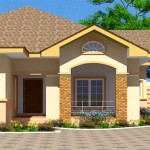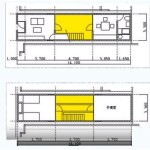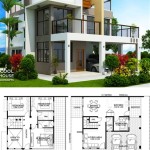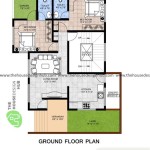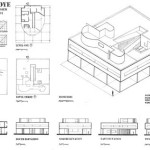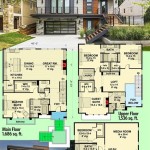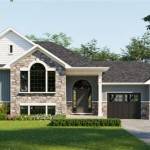Modern House Plans in 3D
Modern house plans in 3D represent a significant advancement in architectural design and visualization. They offer a level of detail and immersion previously unavailable with traditional 2D blueprints, allowing clients and builders to experience a proposed home in a realistic, interactive format before construction begins. This technology bridges the gap between abstract drawings and the tangible reality of a finished house.
3D house plans utilize specialized software to create a virtual model of a home. These models can depict exterior features, including the roof, siding, windows, doors, landscaping, and surrounding terrain. Internally, 3D models can showcase room layouts, wall placements, furniture arrangements, kitchen designs, bathroom fixtures, and even the flow of natural light. This comprehensive visualization allows for a more thorough understanding of the spatial relationships and design elements within the house.
One of the primary benefits of using 3D house plans is the enhanced communication they facilitate between clients and architects. The interactive nature of the models allows clients to virtually "walk through" the house, explore different perspectives, and gain a clearer sense of the scale and proportion of each room. This immersive experience helps clients articulate their preferences and provide feedback more effectively, leading to a more collaborative and satisfying design process.
Furthermore, 3D house plans minimize the potential for costly errors and misunderstandings during construction. The detailed visualization allows builders to identify potential conflicts or challenges early on, such as plumbing and electrical clashes or structural issues. By addressing these concerns in the planning phase, costly rework and delays can be avoided, resulting in a more efficient and streamlined construction process.
Various software options are available for creating 3D house plans, ranging from professional-grade architectural design suites to more user-friendly applications for DIY enthusiasts. These tools offer a range of features, including the ability to import existing 2D floor plans, customize materials and finishes, and generate photorealistic renderings. The choice of software depends on the complexity of the project and the user's technical expertise.
The level of detail in 3D house plans can vary significantly. Basic models may primarily focus on the overall structure and layout of the house, while more advanced models can incorporate intricate details such as furniture, appliances, lighting fixtures, and even landscaping elements. The level of detail required depends on the specific needs of the project and the desired level of realism.
Beyond visualization, 3D house plans can be integrated with other technologies to enhance the design and construction process. For instance, Building Information Modeling (BIM) software can link 3D models with construction schedules, cost estimations, and materials lists. This integration facilitates better project management and allows for more accurate budgeting and resource allocation.
Virtual reality (VR) and augmented reality (AR) technologies are also increasingly being used in conjunction with 3D house plans. VR allows clients to fully immerse themselves in the virtual model of their home, providing an even more realistic and engaging experience. AR, on the other hand, can overlay the 3D model onto the real-world construction site, allowing builders to visualize the design in context and ensure accurate placement of building elements.
The increasing affordability and accessibility of 3D modeling software and hardware have contributed to the widespread adoption of 3D house plans. As technology continues to evolve, we can expect even more sophisticated and powerful tools for creating and interacting with 3D house plans, further revolutionizing the architectural design and construction industries.
The use of 3D house plans is not limited to new construction. They can also be valuable for renovations and remodeling projects. By creating a 3D model of an existing house, homeowners can visualize potential changes and additions, experiment with different layouts and design options, and communicate their vision more effectively with contractors.
In addition to residential projects, 3D house plans are also used in commercial and industrial applications. They can be used to design office buildings, retail spaces, factories, and other complex structures. The ability to visualize the entire project in 3D allows architects and engineers to optimize space utilization, improve workflow efficiency, and ensure compliance with building codes and regulations.
When selecting a provider for 3D house plans, it's essential to consider factors such as experience, expertise, software proficiency, and communication skills. Reviewing portfolios and testimonials can provide valuable insights into the quality of their work and their ability to meet client needs.
The evolution of 3D house plans signifies a paradigm shift in how homes are designed and built. By providing a more immersive, interactive, and informative representation of a proposed home, 3D house plans empower clients, architects, and builders to collaborate more effectively, minimize errors, and ultimately create better homes.

3d House Plans Interior Design Ideas

Modern Home 3d Floor Plans Everyone Will Like Acha Homes

3d Floor Plans Renderings Visualizations Fast Delivery

20 Splendid House Plans In 3d Pinoy

Modern House Plan 10x13 5 Meter 3 Bedrooms Design 3d

Top 10 Modern 3d Small Home Plans Everyone Will Like Acha Homes

Artstation Beautiful Modern 3d House Floor Plan Usa

Modern Villas 3d Floor Plans N House 20x30 Duplex

1000 3d Floor Plans And Home Design Ideas To Build Free Plan House Imagination Shaper

25 More 3 Bedroom 3d Floor Plans

